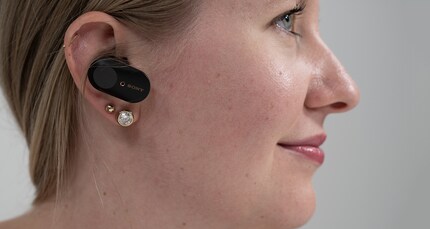
Product test
Sony WH-1000XM4 Review: What can the best noise-cancelling headphones do?
by Livia Gamper
Sony's new wireless in-ear headphones are equipped with convincing noise cancelling. I tested the WF-1000XM3 for a week and can say that the buds are almost unimpeachably good.
Open the box, take out the transport case, connect quickly via NFC, select the right ear pads and switch on the music. And everything else off. The WF-1000XM3's active noise cancelling impressed me right from the start.
I first tested Sony's noise cancelling system in the office. The noise level in the digitec editorial team is usually too high. Everyone often talks over each other. And preferably across the office. At one of those moments when my work colleagues have to talk over my head about something really important, I receive the Sony WF-1000XM3 from our Category Management for testing. The headphones are a blessing.
Next to me, my colleague Dominik Bärlocher is banging on his desk top for some reason. I can feel the slight vibration. I can't hear anything. That's how it is with the WF-1000XM3 - I just listen to music. When my colleagues leave for the evening, I don't notice a thing. Apparently they said goodbye to me five times.
In addition to the noise reduction, I think the sound of the WF-1000XM3 is pretty great. Even when I only listen to music at half volume, the headphones still have a lot of punch - that's how it should be.
Next, I listen to Miracle by the Scottish electropop band Chvrches. Their singer has a very high voice. I'm curious to see how the WF will bring it out.
I quickly realise that the headphones produce a very powerful sound despite this high-pitched voice. The highs are no problem. Nothing overlaps. The synthesiser sounds very full and powerful. As soon as the drums kick in, however, I'm a little surprised. The sound is quite deep here, but not yet muffled. The bass is strong.
The predecessor, the WF-1000X, which came onto the market around two years ago, was much criticised. Connection problems and latency when watching videos made headphone owners angry.
In contrast to the previous model, the two buds are now connected to the smartphone independently. Both earbuds process the signal autonomously. And that works. In my entire test period of one week, I didn't lose the connection or have a dropout once.
I used the headphones a lot on the train. I didn't notice any latency, as was the case with the predecessor. The WF played back the sound to the video without any delay for me.
However, some of my colleagues have complained about the call quality when I'm on the phone. Especially when I was on the phone outdoors with the buds, I got feedback several times that I sounded very choppy. However, nobody complained when making calls indoors.
There aren't many in-ear headphones that come without a cable and with active noise cancelling. And with most of them, you can't adjust the noise cancelling much. And if you do, it lets too much ambient noise through. This is not the case with the WF-1000XM3. And the noise cancelling can be adjusted to a full twenty levels.
In addition to the twenty levels, there is also a wind noise reduction mode. This mode has proven to be very practical with a fan on the table. Without the wind reduction, the headphones do make quite a lot of noise. The mode is certainly also practical in windy weather. Or if you're planning to go cycling with the headphones on.
As with their big brother, the WH-1000XM3 over-ear headphones, they also feature adaptive noise control. This control system uses the sensors on the headphones and smartphone to determine whether you are moving or sitting somewhere and adjusts the sound accordingly. However, every time you make an adjustment, a short beep sounds and the music pauses - if you move around a lot, this can be annoying in the long run.
In the city, the function saves you from being run over by a tram. Otherwise, I preferred to use the WF in noise-cancelling mode. I didn't particularly like the mix between the ambient noise that you hear via the microphone. Not only because I prefer to just listen to music, but also because the noises sounded artificial and more distant to me than they actually are.
If you listen with ANC, the buds have six hours of juice according to Sony. In my case, the right Bud switched off after 5 hours and 45 minutes, the left one after 6 hours and 3 minutes.
Sony provides you with three different foam ear tips and four different silicone ones. The supplied charging cable is very short - but most people have a USB-C cable lying around somewhere at home anyway.
The two buds fit very well in my ears. They never fell out. Even after listening to music for a long time, my ears didn't hurt, even though the buds sit firmly in my ears. However, the bean-shaped dividers do protrude quite generously from the ears. That's not so pretty.
Noise cancelling, sound and functions are good on the MF. However, there are a few points that Sony could improve. I think it's a shame that the WF-1000XMR3 is not waterproof. Nor is it sweatproof. This means you shouldn't take it jogging or to the gym. Unless you're sure you won't sweat in your ears. Too bad, because they would actually be suitable as sports headphones.
Sony has its own high-res audio codec for Bluetooth transmission. The standard is called LDAC. Actually a great thing. Especially for people who don't just want to stream their music from Spotify at a low bit rate, but want to listen to their music in high quality. The problem is that the WF-1000XM3 does not support this standard. And neither does Aptx, the Bluetooth codec from Android.
I often missed the option of being able to adjust the volume on the headphones themselves. Unfortunately, this is only possible on the mobile with the WF.
The WF-1000XM3 is convincing. It can do the most important things: play music in tune and keep noise out. The noise cancelling in particular is overwhelming, especially for in-ear headphones. The operation is good and the functions work. But there are a few small details missing that would make the WF perfect.
However, Sony has taken the feedback about the rather poor predecessor model seriously and has now improved these points. The WF has no problems that bother me when listening to music.
The WF will probably not be good enough for audiophiles - but these people are not the target group for these headphones. It's for those who want peace and quiet when commuting and simply want to take the headphones with them. And the WF is perfect for that.
Testing devices and gadgets is my thing. Some experiments lead to interesting insights, others to demolished phones. I’m hooked on series and can’t imagine life without Netflix. In summer, you’ll find me soaking up the sun by the lake or at a music festival.
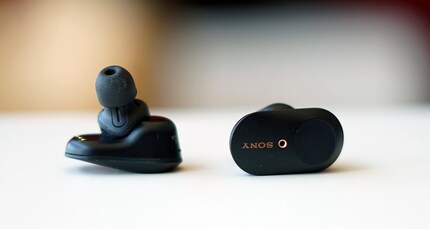
The first song I listen to is No Love by Eminem. With the intro to the rap song, I like the depth and the round sound that I get with the WF. Ever since I saw the rap god live last year, his music has always been a favourite of mine.
As soon as the rap part starts, I'm surprised at how clearly Eminem and Lil Wayne's voices come across. Despite activating noise cancelling, I never have the feeling that the sound is floating away - as has happened to me with some noise cancelling headphones. With the WF, everything is always clear and powerful. And it's perfectly tuned. That's a joy. The overall sound is very round, the highs don't stand out and the lows don't drop off. I like it.
I'm someone who likes to listen to music with a lot of bass. With the WF-1000XM3, however, I had the feeling that there was almost too much bass, depending on the song - people who like a lot of bass will definitely like the headphones. For others, Sony provides a lot of customisation options in the Headphones Connect app. You can choose between eight presets, adjust everything manually yourself and save two customised sets. The difference you can achieve with the equaliser is remarkable - and shows the broad sound spectrum of the WF.

This is a detail, but it has almost driven me up the wall with some headphones: the voice guidance. With the WF, fortunately, it's a very pleasant female voice that tells you that the headphones are switched on, how much battery you have left and that the headphones are connected to your mobile. Since the voice sounds every time you switch on and off and every time you change modes, I find it very pleasing that it's a nice voice that doesn't immediately make your toenails curl up.
I use the WF with my Honor View 20 mobile phone. With the phone, I always had the problem with various Bluetooth devices that the phone and the playback device were paired but the devices were not connected. This has never happened to me with the WF. As soon as I take the buds out of the Böxli and the Bluetooth on the mobile is switched on, the headphones connect automatically, quickly and reliably.
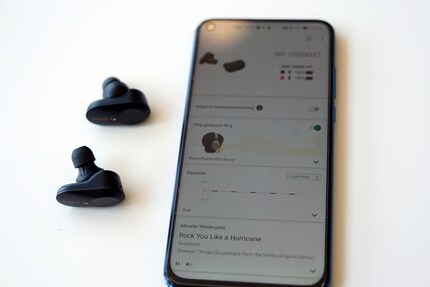
Sony has built a proximity sensor into the headphones. This ensures that the music pauses as soon as you take one of the buds out of your ear. This works reliably. When you put them back in, the music continues to play reliably. However, the sensor doesn't always work if you hold one of the buds in your hand or in the Böxli for longer. Sometimes the WF holds my hands for my ear and simply continues to play the music. If a Bud is in the Böxli, the Autostop no longer works. But otherwise I had no problems when I was only listening to music or talking on the phone with one bud.
On the other hand, the controls on the buds work very well. The default setting is that the music stops immediately when you place your finger on the left bud. One tap changes the noise cancelling mode. On the right bud, you can pause the music with a single tap, go to the next song with two taps and to the previous song with three taps. If you don't like this operation, you can change it in the app and, for example, swap left and right or activate the Google Assistant with the headphones. Tapping works reliably and precisely. The only thing I miss is the function to adjust the volume on the buds.
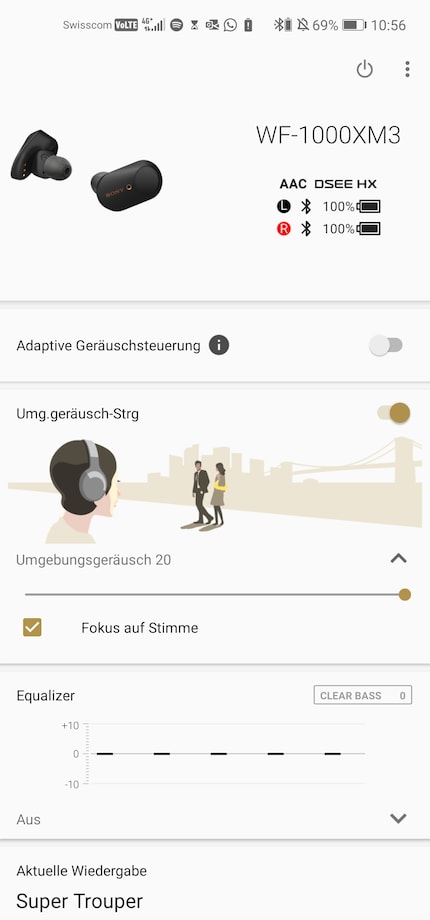
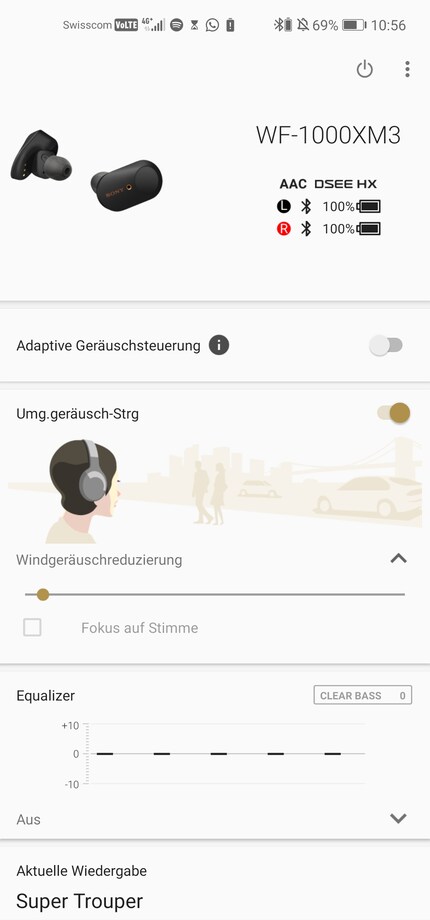
Compared to other in-ear headphones, the WF case is unexpectedly large. But there is also space for three battery charges. The headphones charge automatically as soon as you put them in the case. The case cannot be switched off. The battery status of the case is not displayed. I didn't realise that the case had run out of power. The battery level of the Buds is always announced or displayed when you switch it on and in the app. And when charging, the front of the case lights up red.
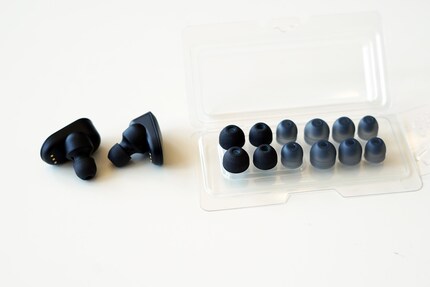
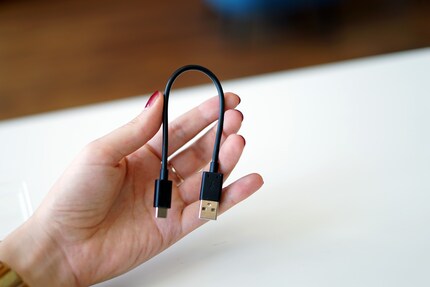
To compensate for the missing standards, Sony has built in another, also proprietary "standard". This is called DSEE HX, which stands for Digital Sound Enhancement Engine and, according to Sony, is almost high-resolution audio quality. You can only activate the standard in the Sony app. For me, the sound quality was fine - I tested the WF with an Android phone. If you use the headphones with an iPhone, you can use the headphones with AAC.
With Android, the Bluetooth codec would be downgraded to SBC. If you want to prevent this, you can activate AAC in the Android developer options on the vast majority of newer phones. You can find instructions in German here
.
Other than that, I miss the search function in case I misplace one of the small handsets. I had to search for one of the buds for half an hour during my week at the weekend. A location function in the app would have saved me that.
